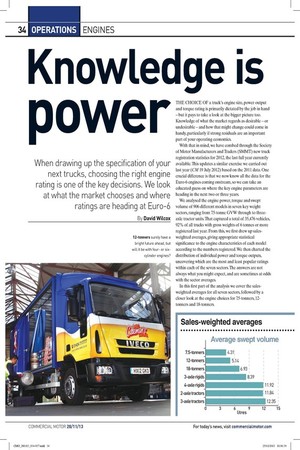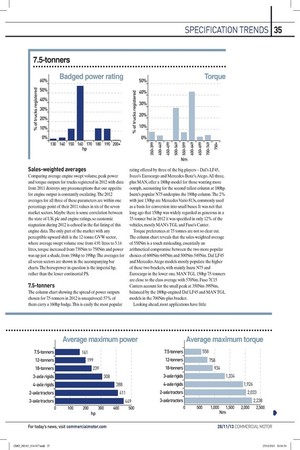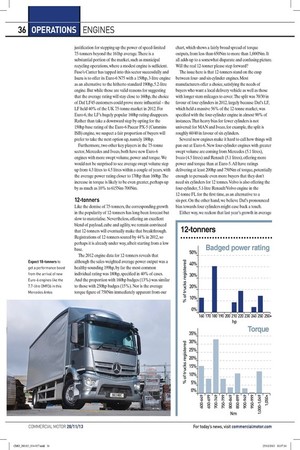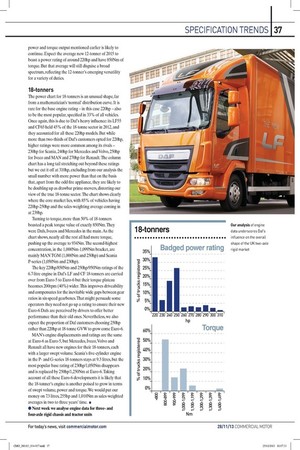Knowledge is
Page 27

Page 28

Page 29

Page 30

If you've noticed an error in this article please click here to report it so we can fix it.
power
When drawing up the specification of your next trucks, choosing the right engine rating is one of the key decisions. We look at what the market chooses and where ratings are heading at Euro-6 By David Wilcox
THE CHOICE OF a truck's engine size, power output and torque rating is primarily dictated by the job in hand — but it pays to take a look at the bigger picture too. Knowledge of what the market regards as desirable — or undesirable — and how that might change could come in handy, particularly if strong residuals are an important part of your operating economics.
With that in mind, we have combed through the Society of Motor Manufacturers and Traders (SMMT) new truck registration statistics for 2012, the last full year currently available. This updates a similar exercise we carried out last year (CM 19 July 2012) based on the 2011 data. One crucial difference is that we now know all the data for the Euro-6 engines coming onstream, so we can take an educated guess on where the key engine parameters are heading in the next two or three years.
We analysed the engine power, torque and swept volume of 906 different models in seven key weight sectors, ranging from 7.5-tonne GVVV through to threeaxle tractor units. That captured a total of 35,476 vehicles, 92% of all trucks with gross weights of 6 tonnes or more registered last year. From this, we first drew up salesweighted averages, giving appropriate statistical significance to the engine characteristics of each model according to the numbers registered. We then charted the distribution of individual power and torque outputs, uncovering which are the most and least popular ratings within each of the seven sectors. The answers are not always what you might expect, and are sometimes at odds with the sector averages.
In this first part of the analysis we cover the salesweighted averages for all seven sectors, followed by a closer look at the engine choices for 7.5-tonners, 12tonners and 18-tonners. Sates-weighted averages
Comparing average engine swept volume, peak power and torque outputs for trucks registered in 2012 with data from 2011 destroys any preconceptions that our appetite for engine output is constantly escalating. The 2012 averages for all three of these parameters are within one percentage point of their 2011 values in six of the seven market sectors. Maybe there is some correlation between the state of UK plc and engine ratings, so economic stagnation during 2012 is echoed in the flat-lining of this engine data. The only part of the market with any perceptible upward shift is the 12-tonne GVVV sector, where average swept volume rose from 4.91 litres to 5.14 litres, torque increased from 739Nm to 758Nm and power was up just a shade, from 196hp to 199hp. The averages for all seven sectors are shown in the accompanying bar charts. The horsepower in question is the imperial hp, rather than the lesser continental PS. 7.5-tonners The column chart showing the spread of power outputs chosen for 7.5-tonners in 2012 is unequivocal: 57% of them carry a 160hp badge. This is easily the most popular
rating offered by three of the big players — Daf's LF45, Iveco's Eurocargo and Mercedes-Benz's Atego. All three, plus MAN, offer a 180hp model for those wanting more oomph, accounting for the second tallest column at 180hp. Isuzu's popular N75 underpins the 190hp column. The 2% with just 130hp are Mercedes Vario 813s, commonly used as a basis for conversion into small buses. It was not that long ago that 150hp was widely regarded as generous in a 7.5-tonner but in 2012 it was specified in only 12% of the vehicles, mostly MAN's TGL and Fuso's Canter. Torque preferences at 7.5 tonnes are not so clear cut. The column chart reveals that the sales-weighted average of 558Nm is a touch misleading, essentially an
arithmetical compromise between the two more popular choices of 600Nm-649Nm and 500Nm-549Nm. Daf LF45 and Mercedes Atego models mostly populate the higher of these two brackets, with mainly Isuzu N75 and Eurocargo in the lower one. MAN TGL 150hp 7.5-tonners are close to the class average with 570Nm.Fuso 7C15 Canters account for the small peak at 350Nm-399Nm, balanced by the 180hp-engined Daf LF45 and MAN TGL models in the 700Nm-plus bracket. Looking ahead, most applications have little
justification for stepping up the power of speed-limited 7.5-tonners beyond the 161hp average. There is a substantial portion of the market, such as municipal recycling operations, where a modest engine is sufficient. Fuso's Canter has tapped into this sector successfully and Isuzu is to offer its Euro-6 N75 with a 150hp, 3-litre engine as an alternative to the hitherto standard 190hp, 5.2-litre engine. But while those are valid reasons for suggesting that the average rating will stay close to 160hp, the choice of Daf LF45 customers could prove more influential the LF held 40% of the UK 7.5-tonne market in 2012. For Euro-6, the LF's hugely popular 160hp rating disappears. Rather than take a downward step by opting for the 150hp base rating of the Euro-6 Paccar PX-5 (Cummins ISB) engine, we suspect a fair proportion of buyers will prefer to take the next option up, namely 180hp.
Furthermore, two other key players in the 75-tonne sector, Mercedes and Iveco, both have new Euro-6 engines with more swept volume, power and torque. We would not be surprised to see average swept volume step up from 4.3 litres to 4.5 litres within a couple of years, with the average power rating closer to 170hp than 160hp. The increase in torque is likely to be even greater, perhaps up by as much as 10% to 615Nm-700Nm. 12-tonners
Like the demise of 7.5-tonners, the corresponding growth in the popularity of 12-tonners has long been forecast but slow to materialise. Nevertheless, offering an excellent blend of payload, cube and agility, we remain convinced that 12-tonners will eventually make that breakthrough. Registrations of 12-tonners soared by 44% in 2012, so perhaps it is already under way, albeit starting from a low base. The 2012 engine data for 12-tonners reveals that although the sales-weighted average power output was a healthy-sounding 199hp, by far the most common individual rating was 180hp, specified in 40% of cases. And the proportion with 160hp badges (13%) was similar to those with 250hp badges (15%). Nor is the average torque figure of 758Nm immediately apparent from our
chart, which shows a fairly broad spread of torque outputs, from less than 650Nm to more than 1,000Nm. It all adds up to a somewhat disparate and confusing picture. Will the real 12-tonner please step forward?
The issue here is that 12-tonners stand on the cusp between fourand six-cylinder engines. Most manufacturers offer a choice, satisfying the needs of buyers who want a local delivery vehicle as well as those with longer stem mileages to cover. The split was 70/30 in favour of four cylinders in 2012, largely because Daf's LF, which held a massive 56% of the 12-tonne market, was specified with the four-cylinder engine in almost 90% of instances. That heavy bias for fewer cylinders is not universal: for MAN and Iveco, for example, the split is roughly 60/40 in favour of six cylinders.
Several new engines make it hard to call how things will pan out at Euro-6. New four-cylinder engines with greater swept volume are coming from Mercedes (5.1 litres), Iveco (4.5 litres) and Renault (5.1 litres), offering more power and torque than at Euro-5. All have ratings delivering at least 200hp and 750Nm of torque, potentially enough to persuade even more buyers that they don't need six cylinders for 12 tonnes. Volvo is also offering the four-cylinder, 5.1-litre Renault/Volvo engine in the 12-tonne FL for the first time, as an alternative to a six-pot. On the other hand, we believe Daf's pronounced bias towards four cylinders might ease back a touch. Either way, we reckon that last year's growth in average
power and torque output mentioned earlier is likely to continue. Expect the average new 12-tonner of 2015 to boast a power rating of around 220hp and have 850Nm of torque. But that average will still disguise a broad spectrum, reflecting the 12-tonner's emerging versatility for a variety of duties. 18-tonners
The power chart for 18-tonners is an unusual shape, far from a mathematician's 'normal' distribution curve. It is rare for the base engine rating — in this case 220hp — also to be the most popular, specified in 33% of all vehicles. Once again, this is due to Daf's heavy influence: its LF55 and CF65 held 45% of the 18-tonne sector in 2012, and they accounted for all these 220hp models. But while more than two-thirds of Daf's customers opted for 220hp, higher ratings were more common among its rivals — 230hp for Scania, 240hp for Mercedes and Volvo, 250hp for Iveco and MAN and 270hp for Renault. The column chart has a long tail stretching out beyond these ratings but we cut it off at 310hp, excluding from our analysis the small number with more power than that on the basis that, apart from the odd fire appliance, they are likely to be doubling up as drawbar prime-movers, distorting our view of the true 18-tonne sector. The chart shows clearly where the core market lies, with 85% of vehicles having 220hp-250hp and the sales-weighting average coming in at 239hp.
Turning to torque, more than 50% of 18-tonners boasted a peak torque value of exactly 850Nm. They were Dafs, Ivecos and Mercedes in the main. As the chart shows, nearly all the rest all had more torque, pushing up the average to 934Nm. The second-highest concentration, in the 1,000Nm-1,099Nm bracket, are mainly MAN TGM (1,000Nm and 250hp) and Scania P-series (1,050Nm and 230hp).
The key 220hp/850Nm and 250hp/950Nm ratings of the 6.7-litre engine in Daf's LF and CF 18-tonners are carried over from Euro-5 to Euro-6 but their torque plateau becomes 200rpm (40%) wider. This improves driveability and compensates for the inevitable wide gaps between gear ratios in six-speed gearboxes. That might persuade some operators they need not go up a rating to ensure their new Euro-6 Dafs are perceived by drivers to offer better performance than their old ones. Nevertheless, we also expect the proportion of Daf customers choosing 250hp rather than 220hp at 18-tonne GVVV to grow come Euro-6. MAN's engine displacements and ratings are the same at Euro-6 as Euro-5, but Mercedes, Iveco, Volvo and Renault all have new engines for their 18-tonners, each with a larger swept volume. Scania's five-cylinder engine in the Pand G-series 18-tonners stays at 9.3 litres, but the most popular base rating of 230hp/1,050Nm disappears and is replaced by 250hp/1,250Nm at Euro-6. Taking account of all these Euro-6 developments it is likely that the 18-tonner's engine is another poised to grow in terms of swept volume, power and torque. We would put our money on 7.3 litres, 255hp and 1,010Nm as sales-weighted averages in two to three years' time. • • Next week we analyse engine data for threeand four-axle rigid chassis and tractor units







































